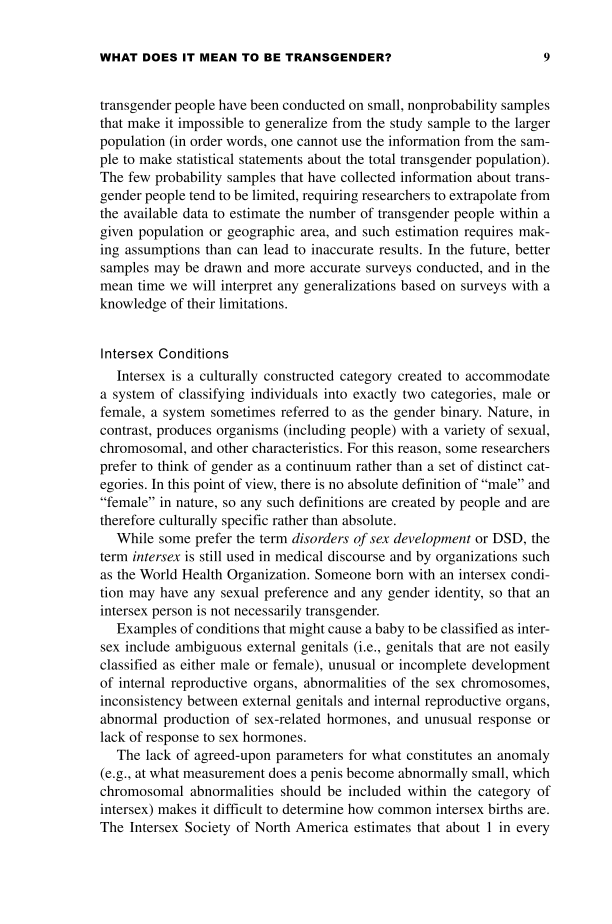WHAT DOES IT MEAN TO BE TRANSGENDER? 9 transgender people have been conducted on small, nonprobability samples that make it impossible to generalize from the study sample to the larger population (in order words, one cannot use the information from the sam- ple to make statistical statements about the total transgender population). The few probability samples that have collected information about trans- gender people tend to be limited, requiring researchers to extrapolate from the available data to estimate the number of transgender people within a given population or geographic area, and such estimation requires mak- ing assumptions than can lead to inaccurate results. In the future, better samples may be drawn and more accurate surveys conducted, and in the mean time we will interpret any generalizations based on surveys with a knowledge of their limitations. Intersex Conditions Intersex is a culturally constructed category created to accommodate a system of classifying individuals into exactly two categories, male or female, a system sometimes referred to as the gender binary. Nature, in contrast, produces organisms (including people) with a variety of sexual, chromosomal, and other characteristics. For this reason, some researchers prefer to think of gender as a continuum rather than a set of distinct cat- egories. In this point of view, there is no absolute definition of „male‰ and „female‰ in nature, so any such definitions are created by people and are therefore culturally specific rather than absolute. While some prefer the term disorders of sex development or DSD, the term intersex is still used in medical discourse and by organizations such as the World Health Organization. Someone born with an intersex condi- tion may have any sexual preference and any gender identity, so that an intersex person is not necessarily transgender. Examples of conditions that might cause a baby to be classified as inter- sex include ambiguous external genitals (i.e., genitals that are not easily classified as either male or female), unusual or incomplete development of internal reproductive organs, abnormalities of the sex chromosomes, inconsistency between external genitals and internal reproductive organs, abnormal production of sex-related hormones, and unusual response or lack of response to sex hormones. The lack of agreed-upon parameters for what constitutes an anomaly (e.g., at what measurement does a penis become abnormally small, which chromosomal abnormalities should be included within the category of intersex) makes it difficult to determine how common intersex births are. The Intersex Society of North America estimates that about 1 in every
Document Details My Account Print multiple pages
Print
You have printed 0 times in the last 24 hours.
Your print count will reset on at .
You may print 0 more time(s) before then.
You may print a maximum of 0 pages at a time.
























































































































































































































